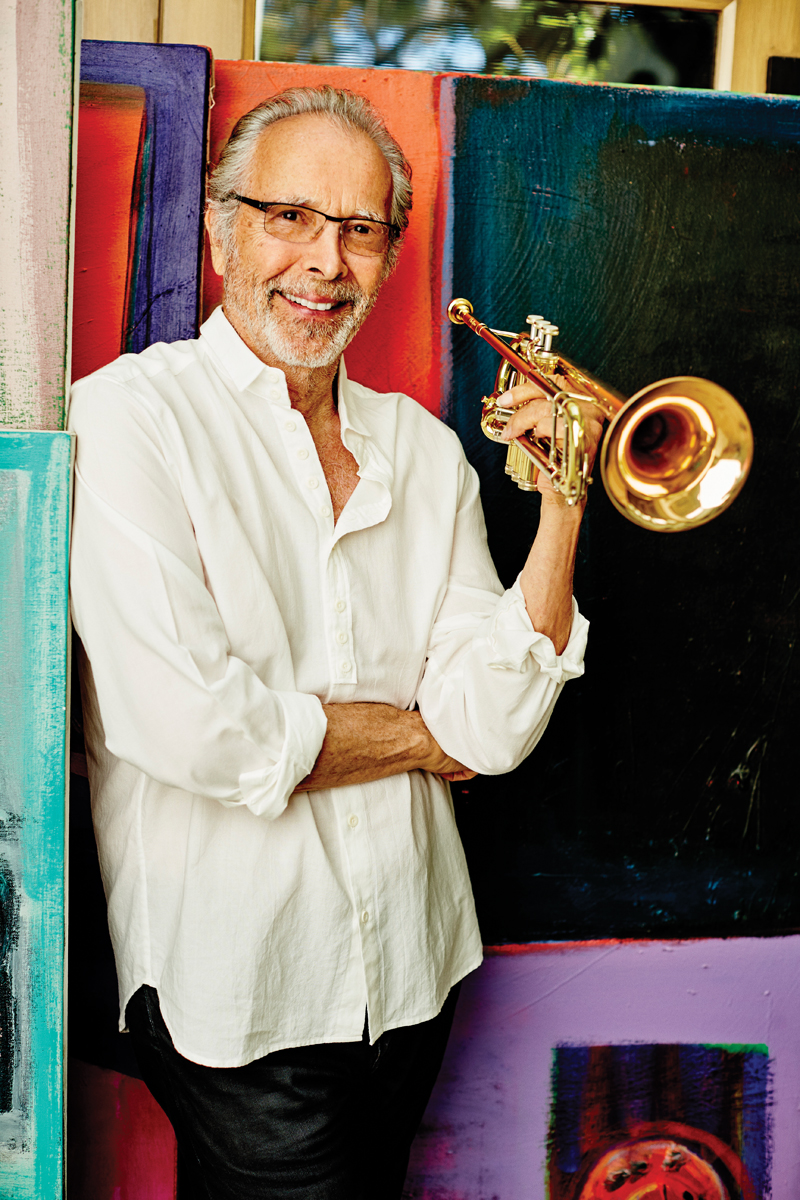HERB ALPERT TALKS BACK WITH OFF BEAT MAGAZINE
Herb Alpert, the trumpet-playing leader of the Tijuana Brass and co-founder of the enormously successful A&M Records, makes his New Orleans Jazz and Heritage Festival debut on May 4.
In the 1960s, Alpert’s infectious, South of the Border sound sustained a ubiquitous presence on pop radio. His sales of 72 million albums led Billboard to rank him number 7 in the Greatest of All Time Billboard 200 Artists chart; listed a few spaces below the first- and second-ranked Beatles and Rolling Stones, Alpert places above Michael Jackson, Taylor Swift, Bruce Springsteen, Led Zeppelin and Madonna. This is an amazing achievement for a mostly instrumental act who, despite massive pop success, is essentially a jazz artist.
Alpert’s Top 40 hits began in 1962 with his style-defining “The Lonely Bull.” The hits continued with “Mexican Shuffle,” “Spanish Flea” and the Grammy-winners “A Taste of Honey” and “What Now My Love.” Alpert’s uncharacteristic vocal performance of Burt Bacharach’s “This Guy’s in Love with You” reached number one in 1968. More than a decade later, his hypnotic “Rise” became a dance-hit phenomenon.
The best-known Tijuana Brass recordings also include “Whipped Cream.” New Orleans composer-pianist Allen Toussaint wrote “Whipped Cream” for Al Hirt. After the local trumpet star rejected it, Henry Hildebrand, A&M Records’ distributor in New Orleans, played the “Whipped Cream” demo over the phone for Alpert. “Whipped Cream” became the title track for the hit 1965 album Whipped Cream & Other Delights, and the theme song for TV’s The Dating Game.
Alpert’s sales statistics include 5 number one hits, 15 gold albums and 14 million-selling albums. He won his ninth Grammy for his 2014 album, Steppin’ Out. In this decade, his recent creative surge produced four albums in three years, including 2016’s electronic- and dance music-inspired Human Nature.
A painter and sculptor, Alpert, 82, stays busy making both music and art. He’s also a philanthropist who supports many arts and cultural organizations, including UCLA’s Herb Alpert School of Music.
Alpert and his wife, former Brasil ’66 singer Lani Hall, live in Southern California on a six-acre estate above the Pacific Ocean. Alpert, Hall and their three-piece band have been performing together for the past 11 years. In advance of his Jazz & Heritage Festival appearance, Alpert spoke to OffBeat.
Are you looking forward to your Jazz Fest debut?
Are you kidding? I’m excited. We’ve been trying to get there for years.
Can you give us a preview?
We’ll have a great band. Very transparent. Just bass, drums, keyboards, myself and Lani. We’re not hiding behind a thousand strings. We know the basic forms of the songs we play, but within that context the guys are free to play whatever they want. I’m free to play whatever I want.
You didn’t have that kind of freedom on stage with the Tijuana Brass?
When I played the Tijuana Brass music in the ’60s, it was the same thing every night, give or take a little bit of this, that and the other thing that happened.
Do you feel lucky?
Absolutely. Timing plays such an important part in the success I’ve had. You can be prepared, but if your timing is wrong, it’s not going to happen. There are a lot of great musicians out there struggling. It’s a matter of being at the right place.
The sound of your trumpet—and the sound of the Tijuana Brass recordings—is immediately identifiable. What led you to that sound?
All artists should be looking for their own voices. I went through a period of trying to sound like Harry James and Louis Armstrong and Miles [Davis]. And then when Clifford Brown came along, it was almost discouraging. The guy was so good! But I kept at it. I loved playing. And then when I heard Les Paul multitrack his guitar on recordings, I tried that with the trumpet. Boom—that sound came out.
After I released ‘The Lonely Bull,’ the record that started A&M in 1962, a lady in Germany wrote a letter to me. She said, ‘Thank you, Mr. Alpert, for sending me on a vicarious trip to Tijuana.’ I realized that music was visual for her, that it took her someplace. I said, ‘That’s the type of music I want to make. I want to make music that transports people.’
Before you picked up a trumpet at eight years old, you were a shy Jewish kid in East Los Angeles. Did the trumpet become your voice?
I still am super shy—a card-carrying introvert. But when I played the trumpet, it talked for me.
You studied classical trumpet early in your life. But that style ultimately wasn’t what you wanted to play?
I wasn’t crazy about playing other people’s notes. Miles [Davis] and the great jazz musicians seduced me. I wanted to close my eyes and just invent and play.
Before you developed the Tijuana Brass concept, you and your songwriting partner at the time, Lou Adler (future founder of the Dunhill and Ode record labels), wrote “Wonderful World” and “Only Sixteen” for Sam Cooke. Did Cooke make a big impression on you?
Sam didn’t know it, but he was a mentor. He came out of gospel music. It was all about feel for him. And he used to say, ‘Herbie, you were just listening to a cool piece of wax, man. It either makes it or it don’t.’ It’s not about technique. It’s not about how wonderful you look. It’s about the feeling.
Early in your career, you signed with RCA Records as a solo artist. Did your experience at RCA influence your approach to making music and also leading A&M Records, the label whose artists included the Police, Peter Frampton, the Neville Brothers, Aaron Neville, the Carpenters, Sheryl Crow, Janet Jackson, Sergio Mendes & Brasil ’66, Cat Stevens and Supertramp?
I wasn’t crazy about the way the major label treated me. I was a number, not a name—38257, tape two. And their recording facilities were very cold. White on white on white. I never felt comfortable. So, I said, ‘Man, if I ever have a chance to have my own company, I will do it a different way.’ I took all that information and put it into A&M.
With “Whipped Cream,” you met Allen Toussaint via the phone and then, nearly 50 years later, you and him were among the 2013 National Medal of Arts Award recipients, presented by President Barack Obama.
I spent a little time with Allen at the White House. He was a real creative guy. He had a unique way of presenting himself.
You also met and performed with New Orleans native and jazz great Louis Armstrong. The two of you performed a duet of “Mame” for a 1967 episode of TV’s The Kraft Music Hall. Was he a major inspiration for you?
He influenced anybody who played an instrument. Louis’ music and his personality were totally in sync. His personality came right through the horn, and it was beautiful.
What was working with Armstrong like?
I was anxious about doing it because of his reputation. But it was fun. An experience I’ll never forget. Because he was such a stellar person. No pretense. He was real.
Earlier you mentioned the importance playing with feeling. Is Armstrong an example of that kind of expressiveness?
When you talk about feel, he’s at the top of the list.
You visited New Orleans in 1968 to film your TV special The Beat of the Brass. While you were here, you and the Tijuana Brass rode a float in the Krewe of Rex parade on Mardi Gras day. Quite an experience?
People were throwing the doubloons. I got hit in the head. The spirit was amazing. I never had anything like that happen before or since.
During that visit, didn’t you also sit in with the Preservation Hall Jazz Band?
Playing with the Preservation Hall Jazz Band, that was an experience all by itself. And New Orleans is probably the most unique city in the whole country. When we did the Mardi Gras, I was there for a couple of weeks. I had a lot of time to get a feel for that city that swings hard.
Swinging forward almost 50 years, you’ve been prolific recently, releasing four albums in three years.
It’s out of my control. I’m a right-brained guy. I love taking a song that’s familiar to people and doing it in a way that hasn’t been done before. I also sculpt and paint. My days are filled with creative stuff.
You have three Burt Bacharach songs on your latest album, Human Nature—“Alfie” and “Don’t Go Breaking My Heart” (by Bacharach and Hal David) and “Look Up Again” (by Bacharach and Elvis Costello). You’ve always had a knack for picking material. What do you look for in a song?
I’m a melody guy. A melody is the thing that turns me on. But I also think all art is a mystery. When you think about the Western lexicon of music, there are only 12 notes. Mozart and Beethoven had those notes. So did Thelonious Monk. Just those 12 notes, but they can be scrambled up in so many different ways.
You apparently have no interest in retiring, but how important is being creative to you now?
It gives me life. I wake up in the morning excited about what I’m going to do. And I must tell you that my incredible wife, Lani, is my muse. She’s one of the reasons life hums for me. We’ve been married for 43 years. We’ve been together close to 50 years. My life wouldn’t be nearly as fulfilling without her. It’s been a fun ride. It’s not over.

